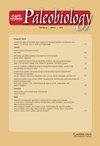Patterns and processes in the history of body size in turritelline gastropods, Jurassic to Recent
IF 2.7
2区 地球科学
Q2 BIODIVERSITY CONSERVATION
引用次数: 2
Abstract
Abstract Body size is an important trait with implications for energy use and ecology as well as generation time and evolutionary rates. Turritelline gastropods are widely distributed through geologic time and space, making them an excellent group for evaluating macroevolutionary patterns. To evaluate the pattern of body-size change in turritelline gastropods, we compiled a dataset of shell lengths of 316 species of turritelline gastropods spanning the Jurassic to Recent. Type specimens were almost always significantly larger than specimen distributions from the same species. We found that turritelline gastropod size was inversely correlated with latitude, a trend likely driven by the Neogene–Recent diversification of small-bodied Southern Hemisphere taxa. A time series model was applied to distinguish among three possible macroevolutionary patterns: unbiased random walk (no directional trend), biased random walk (directional trend), and stasis (no net change). We determined that turritelline gastropods have experienced stasis in body size throughout their evolutionary history, adding to the growing literature documenting directionless body-size trends in marine invertebrate clades. Stasis of geographically widespread clades may be the result of ecological variability across the environmental range occupied by the group or differential diversification into opposing environments. Turritelline life-history patterns, especially their reproductive strategy that combines a short life span and decline in growth rate around 1 year of age to reallocate energy to reproduction, might circumvent selection for longevity and larger size, while further decrease in minimum size is likely limited by feeding efficiency and anti-predatory defense. The expectation that species or clades should continue to evolve to occupy larger size classes conflicts with the evolutionary advantages of small size, which in turritelline gastropods include high generational turnover and larger population sizes that yield opportunities for genetic variance.侏罗纪至近代甲壳纲腹足动物体型变化的模式和过程
体型是一个重要的特征,与能量使用、生态、世代时间和进化速度有关。Turritelline腹足类动物广泛分布于不同的地质时间和空间,是评价宏观演化模式的一个极好的类群。为了评价龟腹纲动物体型的变化规律,我们收集了从侏罗纪到近代的316种龟腹纲动物的壳长数据。模式标本几乎总是明显大于来自同一物种的标本分布。研究发现,菱鲆腹足动物的大小与纬度呈负相关,这一趋势可能是由南半球小体类群新近-新近的多样化所驱动的。采用时间序列模型来区分三种可能的宏观进化模式:无偏随机漫步(无方向趋势)、有偏随机漫步(有方向趋势)和停滞(无净变化)。我们确定,在整个进化史中,turritelline腹足类动物的体型一直处于停滞状态,这为越来越多的文献记录了海洋无脊椎动物进化支系的无方向体型趋势。地理上广泛分布的分支的停滞可能是该群体所占据的环境范围内的生态变异性或向相反环境的差异多样化的结果。Turritelline的生活史模式,特别是它们的繁殖策略,结合了短寿命和1岁左右的生长速度下降,以重新分配能量给繁殖,可能规避了长寿和更大体型的选择,而最小体型的进一步缩小可能受到摄食效率和反掠食性防御的限制。物种或分支应该继续进化以占据更大的类的期望与小尺寸的进化优势相冲突,在turritelline腹足类中,小尺寸的进化优势包括高世代更替和更大的种群规模,从而产生遗传变异的机会。
本文章由计算机程序翻译,如有差异,请以英文原文为准。
求助全文
约1分钟内获得全文
求助全文
来源期刊

Paleobiology
地学-古生物学
CiteScore
5.30
自引率
3.70%
发文量
38
审稿时长
>12 weeks
期刊介绍:
Paleobiology publishes original contributions of any length (but normally 10-50 manuscript pages) dealing with any aspect of biological paleontology. Emphasis is placed on biological or paleobiological processes and patterns, including macroevolution, extinction, diversification, speciation, functional morphology, bio-geography, phylogeny, paleoecology, molecular paleontology, taphonomy, natural selection and patterns of variation, abundance, and distribution in space and time, among others. Taxonomic papers are welcome if they have significant and broad applications. Papers concerning research on recent organisms and systems are appropriate if they are of particular interest to paleontologists. Papers should typically interest readers from more than one specialty. Proposals for symposium volumes should be discussed in advance with the editors.
 求助内容:
求助内容: 应助结果提醒方式:
应助结果提醒方式:


